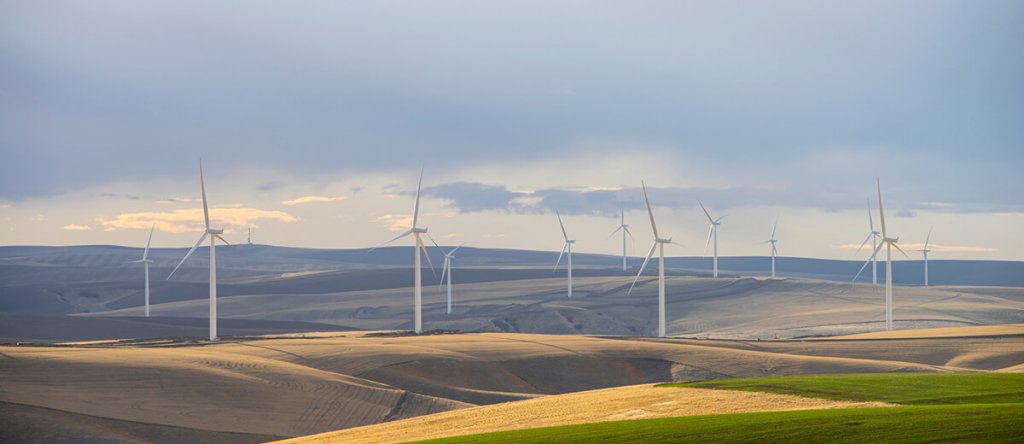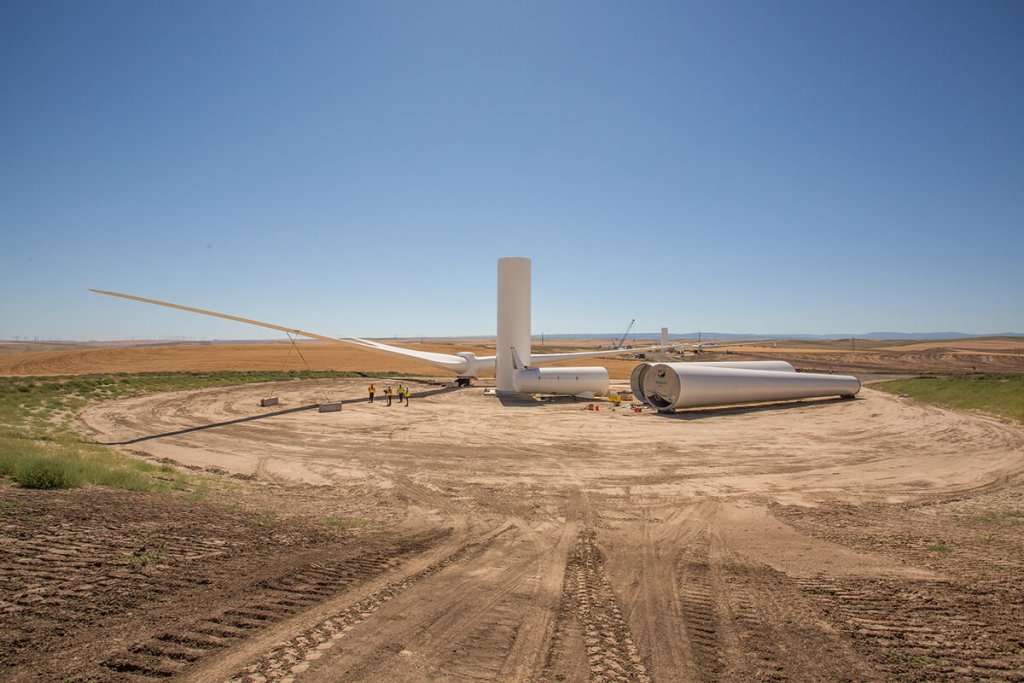When it comes to environmental building standards, LEED (Leadership in Energy & Environmental Design) has become the most widely used third-party verification organization for “green” buildings. Developed by the U.S. Green Building Council, LEED-certified projects earn points based on environmental efficiency standards. For example, a building might reduce emissions by using less energy, less water, or creating less waste.
But what about for infrastructure that falls outside of LEED-approved buildings such as structures that might not house or hold people but still provides a service, such as watersheds…or wind farms?
LEEDs for wind farms
Enter the Institute for Sustainable Infrastructure (ISI) Envision rating system for sustainable infrastructure, the international benchmark for all types of infrastructure.

Portland General Electric’s Tucannon River Wind Farm, shown here, is the first energy project to receive an Institute for Sustainable Infrastructure (ISI) Envision sustainable infrastructure award in North America. Analysis shows that the wind farm will cut carbon dioxide emissions by 92% during its lifetime compared to a conventional power plant with the same capacity. It is located near Dayton, Washington.
Per the ISI’s website: “Envision provides a holistic framework for evaluating and rating the community, environmental, and economic benefits of all types and sizes of infrastructure projects. It evaluates, grades, and gives recognition to projects that use transformational, collaborative approaches to assess the sustainability indicators over the course of a project’s life cycle.”
By the end of 2015, nine projects earned Envision awards across the United States and Canada. Of notable mention to those in the wind industry is the Portland General Electric’s (PGE) Tucannon River Wind Farm, which represents the first energy project to receive an ISI Envision-verified sustainable infrastructure award in North America.
The 267-MW wind farm is located on 20,000 acres near Dayton, Washington, and achieved a Gold rating by meeting many of the highest principles of sustainability. A total of 116 Siemens wind turbines help PGE meet Oregon’s Renewable Portfolio Standard, which requires the utility to supply 15% of the electricity to its customers from qualified renewable resources by 2015 and 25% by 2025.
Construction of the Tucannon River project began in 2013, and the facility went into commercial operation in December of 2014. Before construction began, the design team evaluated ways to reduce the project’s net embodied energy. In this case, that meant turbine foundations were designed to reduce the amount of required concrete and a significant portion of construction materials used in the project was sourced locally. This cut transportation costs and helped boost the local economy.
Even materials excavated during construction were retained and reused onsite where possible, and most of the turbine’s components can be recycled at the end of the project life.
The Envision sustainable infrastructure categories in which the Tucannon River Wind Farm scored highest include:

A tower and rotor are ready for assembly at the Tucannon River Wind Farm during construction in the summer of 2014. The wind farm was sited to avoid all wetlands and surface water, steep slopes, and other potentially fragile or hazardous terrain.
Quality of Life. The project offers benefits to the community including full-time jobs, income for local businesses, increased county tax revenue, and easement payments to landowners. It also benefits the Oregon economy by helping PGE provide customers with renewable energy at a reasonable price.
Leadership. Prior to construction, PGE established plans and resources necessary for long-term monitoring and maintenance of the completed wind farm. Additional environmental monitoring is used during wind-farm operation to manage and protect sensitive natural and cultural resources.
Resource Allocation. Tucannon River Wind Farm will provide a net-positive amount of energy to the grid during the next 20 years. This project’s infrastructure contributes more than 676,000 megawatt-hours of renewable power to the grid each year, decreasing dependence on fossil fuel energy sources and increasing national energy independence.
Natural World. Tucannon River Wind Farm was sited to avoid all wetlands and surface water, floodplains, steep slopes, and other potentially fragile or hazardous terrain. The project was also designed and constructed to avoid surface waters and contamination of waters. The project team reduced the use of hazardous or potentially polluting materials.
Climate and Risk. Analysis shows that the wind farm will cut carbon dioxide emissions by 92% during its lifetime compared to a conventional power plant with the same capacity.
The Tucannon River Wind Farm team thoroughly assessed likely hazards and upgraded designs to prepare for direct and indirect impacts of short-term hazards. In addition to securing infrastructure and configuring its systems for resiliency against man-made hazards, designs were implemented to withstand floods, wildfires, and extreme temperatures and winds. Specific protections were also added to address lightning strikes, ice storms, and seismic events.
The rating system
Envision was created as a joint collaboration between the Institute for Sustainable Infrastructure (the ISI was founded by three national engineering associations: American Society of Civil Engineers, American Council of Engineering Companies, and American Public Works Association) and the Zofnass Program for Sustainable Infrastructure at Harvard University Graduate School of Design.

A large wind-turbine blade is lifted into place onto a rotor hub at the Tucannon River Wind Farm during construction. Special protections have been added to address lightning strikes, ice storms, and seismic events.
Similar to LEED, Envision’s rating system includes points or credits that can earn Bronze, Silver, Gold, and Platinum ratings. The program offers 60 sustainability credits that are divided into five main categories: Quality of Life; Leadership; Resource Allocation; Natural World; and Climate and Risk.
Envision’s sustainable infrastructure rating system can serve infrastructure development or design companies in two ways: as guidelines for a project team to evaluate infrastructure at any stage of the design process, or as means for objective review by ISI verifiers (known as ENV SPs) to assess eligibility for an Envision award.
To help companies better prioritize and meet sustainability goals, Envision also provides evaluation tools so project owners or designers can:
- Assess costs and benefits over the lifecycles of a project,
- Evaluate potential environmental benefits,
- Use outcome-based objectives, and
- Reach higher levels of sustainability achievement.
One example of an educational tool is the Envision Checklist, which helps users familiarize themselves with the sustainability aspects of infrastructure project design. The checklist is structured as a series of “Yes” or “No” questions based on the Envision rating system. It can be used as a stand-alone assessment to quickly compare project alternatives or to prepare for a more detailed assessment.
However, the goal of either the checklist or rating system doesn’t have to be an Envision award. Companies can simply use these tools to measure sustainability in the planning or construction phase of a project for their own purposes, while maintaining full anonymity.
Envision is also updating its program and is currently developing an economic optimization tool, and construction and O&M phase credits.
If interested in submitting a project for an Envision sustainability rating, there are no limits to infrastructure type. For instance, Tucannon River Wind Farm is not the only success story from 2016. The 26th Ward Wastewater Treatment Plant in New York City earned an Envision Silver award last August for its work in upgrading and expanding its treatment capacity. And Canada’s Vancouver-based company, Low Level Road, earned Envision Platinum back in September for its roadwork. The company sustainably realigned and elevated about 2.6 km of a city road to provide space for two new rail tracks and direct access to major port terminals.
What goes into attaining each Envision credit is described in a two-page report that includes the intent, metric, levels of achievement, description, an explanation of how to advance to a higher achievement level, evaluation criteria and documentation, sources, and related credits.
Visit www.sustainableinfrastructure.org for further tools, rating, and application requirements.
Filed Under: News




